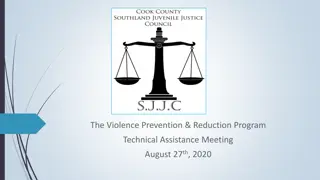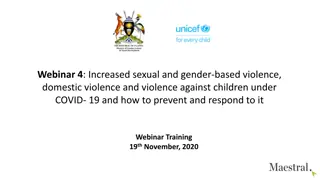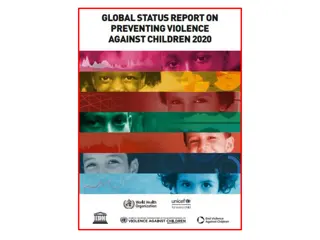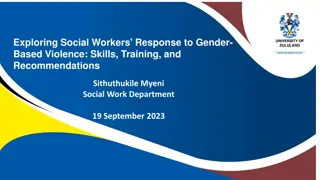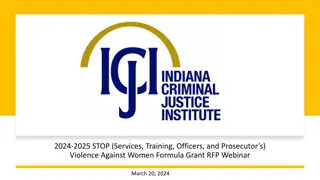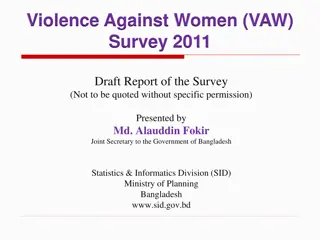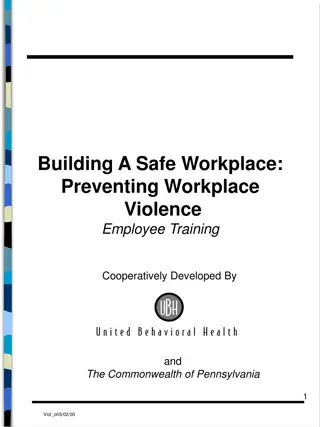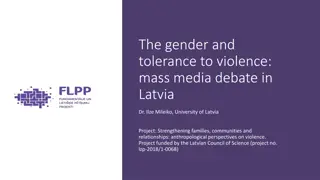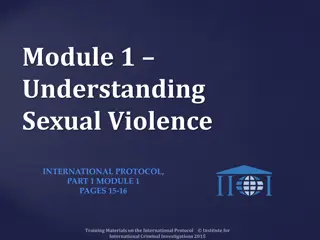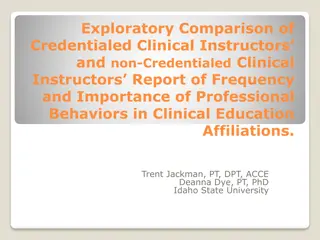NHSL Violence Reduction Clinical & Professional Network Overview
The NHSL Violence Reduction Clinical & Professional Network aims to address the high number of violent incidents in London through a public health approach. Led by Martin Griffiths, the network provides a forum for clinicians and professionals to share expertise, offer strategic leadership, and support system-wide transformation in violence reduction pathways. The network members come from various clinical backgrounds to collaborate on developing best practices and advocating for London's violence reduction program.
Download Presentation

Please find below an Image/Link to download the presentation.
The content on the website is provided AS IS for your information and personal use only. It may not be sold, licensed, or shared on other websites without obtaining consent from the author. Download presentation by click this link. If you encounter any issues during the download, it is possible that the publisher has removed the file from their server.
E N D
Presentation Transcript
NHS London Violence Reduction Clinical and Professional Network 15th October 2019 9am - 11am Agenda item Lead Slide number Welcome and introductions Martin Griffiths Background to the programme Martin Griffiths 2 Draft Terms of Reference, Governance and ways of working Martin Griffiths / Sinead Dervin 3 5 High level programme plan Martin Griffiths 6 Integrated physical and physiological trauma model Sinead Dervin 7 Violence Reduction Academy Martin Griffiths 8 System data and intelligence Emily Treder 9 AOB Martin Griffiths NHS England and NHS Improvement
1. NHSL Violence Reduction Programme: Background The number of violent incidents in London is unacceptably high and has significant impact on individuals, families, communities and our health service. The Mayor of London has established a Violence Reduction Unit to address this by taking a long-term public health approach with key partners such as health, social care, education, housing Violence reduction has also been reflected in the recently published Health and Care Vision and is one of London s ten priority areas. The NHS is a key player within the VRU but as a health service we recognise the need for an independent, coherent health response, looking at opportunities the health system can take to support violence reduction across the capital. To support this a Clinical Director for Violence Reduction has been appointed (Martin Griffiths, Trauma Surgeon at Barts NHS Trust ) as well as NHS London Executive SRO and support from an internal team of NHS and PHE leads and programme management expertise. Establishing a Violence Reduction Clinical and Professional Network is a key part of the programme to provide system leadership and help drive forward the programme deliverables. Draft Terms of Reference for the network are outlined on the following slide. 2 | 2 |
2. Londons Violence Reduction Clinical & Professional Network Terms of Reference and Governance DRAFT Description Membership NHS London Violence Reduction Clinical Director (chair) Clinical representation from London s Trauma Networks Clinical representation from London s A&Es Clinical representation from London s Mental Health Trusts Clinical representation from primary care Representation from the London Ambulance Service Representation from social and community care Representation from public health Representation from the third sector The role of the Violence Reduction Clinical & Professional Network is to provide a forum for clinicians and professionals to meet and share their specialist expertise, clinical expertise and strategic knowledge. The network will act as a clinical and professional expert arm of the NHS London Violence Reduction programme and exists to provide collective knowledge and strategic leadership. The network is responsible for: Providing clinical and professional advice and leadership of system-wide transformation across the violence reduction pathway; To provide support and advice to local systems on the development of pathways / services in regards to the NHS contribution to violence reduction and lead the way in sharing good practice across the capital and nationally; Give expert advice on best-practice pathways which cross organisational and sector boundaries; Acting as advocates for London s violence reduction programme across London s health and care system and supporting stakeholder engagement; Leading the development, and providing endorsement, on the deliverables produced by the programme. Frequency - The network will meet on a quarterly basis for 2-3 hours. It is expected that members will commit the time necessary to understand the issues considered by the network, participate and respectfully in debate and genuinely commit to identifying sustainable strategic decisions on behalf of Londoners. Members are expected to attend most meetings during the year. Additional meetings - Additional Task and Finish groups will be established with network representatives to guide specific programme deliverables outside of the formal meeting structure. Review - The network will review its purpose, function, performance and terms of reference on an annual basis. Quorum - A quorum for meetings will be 50%, including the Chair. As members attend as individuals in their own right, the use of nominated deputies is discouraged. 3 | 3 | *Appendix 1 shows full membership
2. London Violence Reduction Clinical & Professional Network Terms of Reference and Governance Ultimately the programme is accountable to the London Region Executive Team, chaired by Sir David Sloman via the programme s Senior Responsible Officer (Mark Turner) and Clinical Director. The London Violence Reduction Clinical and Professional Network serves as a leadership committee that reports and is accountable to the NHS London Violence Reduction Steering Group. A dedicated Violence Reduction Patient Group is also being established with patients (victims and perpetrators) that have experience and knowledge of health pathways. The patient group will be pivotal in shaping, developing and leading on programme deliverables alongside the network. Do representatives on the Clinical and Professional Network agree with the draft Terms of Reference? Are there additional points and/or responsibilities that need to be outlined? *Note - Meeting dates for the next 12 months are being scheduled 4 | 4 |
3. Londons Violence Reduction Programme: Adopting the NHS Leading Large Scale Change model 5 | 5 |
4. Londons Violence Reduction Programme: High Level Mission statement of the NHS London Violence Reduction Programme: To lead the way in shaping how the NHS can support violence reduction in order to have better wellbeing in our communities at a population and individual level Emerging work streams to achieve the programme s mission: 1. Violence Reduction Clinical and Professional Network and seeking pan-London opportunities Establishing a VR clinical and professional network that plays a leading role in motivating and mobilising local systems, acting as advocates for system-wide transformation at all levels, supporting co-production with users and enhancing current service offers of pan-London NHS services. 2. Establishing a Violence Reduction academy 4. User engagement Early intervention Supporting emotional wellbeing Tertiary prevention Data & intelligence Users supporting and guiding the programme deliverables and helping identify further opportunities Capability building Knowledge & evaluation Mapping of best practice to provide a central repository of evidence based models. Supporting pilots of new pathways/models across London and communicating success. Supporting how to define key metrics and evaluations across the system and knowledge spread of what works and lessons learnt. Facilitating online communities of practice Identification of local champions to facilitate learning locally. Development of educational programmes which support staff. Links with HEE to incorporate VR into curriculum Building collaborative networks - events for professionals across the system to work collaboratively, problem solve, learn from each other, provide peer support and challenge. Data hub that provides intelligence to inform local interventions and support across different health areas (scope to initially focus on areas in blue boxes above) 3. System data capture and intelligence Improving data collection, analysis and sharing mechanisms, ensuring we have a comprehensive dataset across partners looking at the prevalence of injury, risk and protective factors to inform regional, sub-regional and local policy 5. Communications across the health system 6 | 6 |
4a. Violence Reduction Academy 2. Establishing a Violence Reduction academy Early intervention Supporting emotional wellbeing Tertiary prevention Data & intelligence Capability building Knowledge & evaluation Mapping of best practice to provide a central repository of evidence based models. Supporting pilots of new pathways/models across London and communicating success. Supporting how to define key metrics and evaluations across the system and knowledge spread of what works and lessons learnt. Facilitating online communities of practice Identification of local champions to facilitate learning locally. Development of educational programmes which support staff. Links with HEE to incorporate VR into curriculum Building collaborative networks - events for professionals across the system to work collaboratively, problem solve, learn from each other, provide peer support and challenge. Data hub that provides intelligence to inform local interventions and support across different health areas (scope to initially focus on areas in blue boxes above) In the first instance, the academy will be a virtual space where information and data can be stored and an online community can be built; The first phase of establishing the academy will involve a thorough mapping exercise across the system looking at what is happening and sourcing good practice to build the central repository. This phase will also look at opportunities where the NHS can play a greater role in responding to violence reduction and developing material to support local systems in doing so; The first phase will also include making links with HEE and the Royal Colleges to see what opportunities exist in current curriculum to build capability; It is envisioned that the academy will be more formally launched through a sharing good practice event. Representatives on the network to provide comments and feedback on: The scope of the academy and the three focus areas; How we progress establishing the academy and in particular phase one, e.g. sourcing best practice and evidence across the system and particular individuals / organisations the programme should tap into; 7 | 7 | Particular representatives on the network that want to be more involved in this work stream.
4b. System data capture and intelligence Data that collects intelligence on violence, vulnerability and other risk factors is variably collected across different parts of the NHS. Largely it is inconsistent and not collated and analysed in a systematic way to inform service improvements. The objectives of the System Data and Intelligence work stream involves: Identifying data currently collected across the NHS that informs the prevalence of injury from violent acts, and the risk and protective factors associated with violence, Assessing the quality of data currently collected, including its robustness, completeness and comparability across settings and providers, and Developing recommendations on opportunities to strengthen and expand the data collected across the NHS, ensuring that any additional ask of system partners is proportionate and practical to implement. 1. Initial discovery phase Develop a greater understanding of the problem to be solved and what the system wants to change or make happen. This will include engagement with members of both the Violence Reduction Steering Group and Clinical and Professional Network 2. Stocktake of existing data sources, including an assessment of quality - This will cover the range of NHS health settings, including the trauma network and A&Es, LAS, elective care, walk-in centres, GP practices, dentists & liaison and diversion services. This will also include existing data collected in London as part of the Information Sharing to Tackle Violence (ISTV) programme and it is proposed school nurses are also included in scope. This phase will involve explore data systems on hand as well as conducting a range of interviews with representatives across different NHS settings. Approach 3. Developing recommendations on the possibilities to strengthen existing data capture and/or expand the data collected This phase will build on the data quality assessment and consider what is reasonable and practical to revise or collect from a system partner perspective. This would also explore any possible hurdles to recommendations, such as information sharing rules and legislation, contracts, technology, or existing processes and systems. This phase will also specifically look at the ISTV programme both locally and nationally and where opportunities lie to improve this. Representatives on the network to provide comments and feedback on: The scope of the data work stream and required outputs; Any existing work both regionally and nationally to align with; 8 | 8 | Particular representatives on the network that want to be more involved.
Appendix 1: Representatives on Londons Violence Reduction Clinical and Professional Network Consultant Clinical Psychologist & PTSD Lead / Clinical Lead for pan-London outreach and screen service Idit Albert SLAM Reader in Forensic Psychiatry, Kings College & Consultant Forensic Psychiatrist, HMP Wandsworth Consultant Child & Adolescent Psychiatrist Consultant Forensic Psychiatrist Director Of Nursing Chief Executive Head of CCE Development Chief Executive Chief Executive / Clinical Lead Clinical Lead / Clinical Psychologist Clinical Psychologists and Project Leads Medical Director Director of Quality Director of Nursing Clinical Director for Emergency Medicine Senior Sister, Emergency Department Clinical Director for Violence Reduction Consultant in Emergency Medicine (Paeds) Consultant in Emergency Medicine Lead Nurse for Violence Reduction Clinical Lead, London Major Trauma Network Consultant in Emergency Medicine Consultant in Adult and Paediatric Emergency Medicine Director for Children s Services Director of Public Health Director for Children s Services Director of Public Protection and Safety Health & Justice Public Health Specialist GP Principal and Clinical Lead for Mental Health & Dementia Clinical Director of Bromley Connect & GP Senior Partner at Southview Partnership GP Partner Mental Health Nigel Blackwood King s College Tara Weeramanthri Richard Latham Andy Cruickshank Sherry Peck Evan Jones John Poyton Philip Brading / Jo Begent Natalie Seymour Lucy Gore / Hannah Stringer Fenella Wrigley Trisha Bain Tricia Fitzgerald Emer Sutherland Victoria Golden Martin Griffiths (Chair) Gayle Hann Adam Woodgate Michael Carver Karim Brohi Fiona Wisniacki Asif Rahman Florence Kroll Dagmar Zeuner Ann Graham Geeta Subramaniam Simone Thorn Heathcock Raj Kumar SLAM SLAM ELFT Safer London St Giles Redthread UCLH Charity MAC-UK Project Future LAS LAS King's College King's College Whittington Bart s Trust North Middlesex Bart s Trust Bart s Trust Bart s Trust Hillingdon Hospital Imperial Royal Borough of Greenwich Merton Council Haringey Council Lewisham Council PHE BHR CCGs Voluntary / Charity Sector Acute and Major Trauma Centres Local authority / Public Health Primary Emma Ryan Bromley CCG 9 | 9 | Care Arundeep Hansi Enfield CCG







